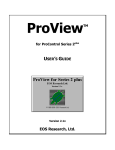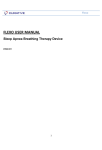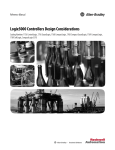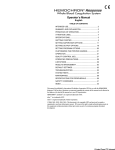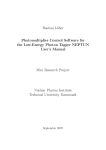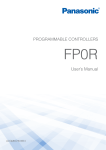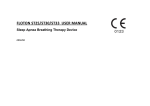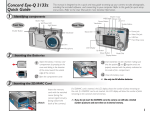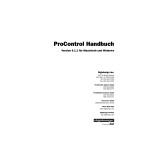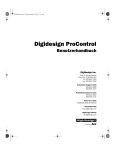Download PROCONTROL SERIES 2plus USER MANUAL
Transcript
PROCONTROL SERIES 2plus USER MANUAL Version 2.X ProControl User’s Manual v2.X LIMITED WARRANTY EOS Research Ltd. (EOS) warrants its products to be free from defects in materials and workmanship for a period of one year from the date of purchase. Its obligation under this warranty is limited to repairing or replacing, at its sole option, any such defective products. This warranty includes parts and labor. This warranty does not apply to equipment which has been damaged by accident, negligence or misapplication or has been altered or modified in any way. EXCEPT AS PROVIDED HEREIN, EOS RESEARCH LTD. MAKES NO WARRANTIES, EXPRESSED OR IMPLIED, INCLUDING WARRANTIES OF MECHANTABILITY AND FITNESS FOR A PARTICULAR PURPOSE. Some states do not permit limitation or exclusion of implied warranties, therefore the aforesaid limitation(s) or exclusion(s) may not apply to the purchaser. This warranty gives you specific legal rights and you may also have other rights which vary from state to state. IMPORTANT SAFETY PRECAUTIONS Any complex hardware or software may be difficult to document, explain or understand. It is important to consider the consequences or unexpected or abnormal behavior which may be caused by a defect or human failure to comprehend. In order to protect people and property from damage, a thorough safety analysis should always be performed. When the consequences of a failure are serious, it is essential to protect life and property against such a failure with redundant backup systems or safety devices. It is agreed between the purchaser and EOS Research Ltd. that protection against and the consequences of any such failure are entirely the purchaser’s responsibility. This device is not approved for use in life support or medical systems. As installed, this product may be part of a system which is required to meet various electrical, fire, safety or other codes and regulations. Compliance with these codes is the purchaser’s responsibility. Specifications subject to change without notice. © 1996-2003 EOS Research Ltd. EOS Research Ltd. 159 Walnut Street Rochester, NH 03867 603.332.2099 Fax: 603.332.2727 [email protected] i \backup\8100\0074.doc ProControl User’s Manual v2.X TABLE OF CONTENTS 1.0 SYSTEM OVERVIEW 1.1 1.2 1.3 1 General Key Concepts Control Basics 1 2 3 2.0 ON-SITE OPERATION 2.1 2.2 2.3 2.4 2.5 2.6 2.7 2.8 2.9 2.10 2.11 3.0 7 LCD Display Keypad Password Operations Screen I/O Keys Digital Input Menu Digital Output Menu Analog Input Menu Analog Output Menu Menu Key LED Indicators 7 9 10 10 11 11 11 12 13 14 17 REPORTING FEATURES 18 3.1 3.2 18 23 Fax Report Page Alerts APPENDIX A - Typical ProControl Wiring Please see the ProView manual for operation of the remote access software which is supplied with the ProControl Series 2plus. ii \backup\8100\0074.doc ProControl User’s Manual v2.X 1.0 SYSTEM OVERVIEW 1.1 General plus The ProControl Series 2 is a small but powerful microprocessor based control/ telemonitoring system. By combining a control panel and remote monitor in one plus unit, the Series 2 can act as a central supervisory and data management tool for plus can perform multiple tasks: any stand-alone operation. The ProControl Series 2 plus • Stand-Alone Control: The ProControl Series 2 is a sophisticated programmable logic controller that will efficiently supervise and control your operation. It can interface with up to 70 electrical devices (float switches, pressure transducers, pH transmitters, flow meters, pumps, blowers, etc.), and execute numerous control functions simultaneously. Automatic shutdown routines can be programmed in to protect you operation during alarm conditions. It is extremely versatile in terms of the control algorithms it can execute. • Remote Control and Monitoring: The ProControl Series 2 gives you a window into your operation from any remote location, using the easy-to-use Windows-based software supplied with the system. You communicate with the ProControl over a modem link, which allows you to view all of your system’s operating conditions, while also providing the same access to control functions that you would have if you were at the site (e.g., turning pumps on and off, adjusting alarm setpoints, etc.). No other telemonitoring device gives you the ProControl’s level of remote control capability. • Reporting: The ProControl Series 2 will keep you informed. It will send you periodic fax status reports of your project operations on a schedule specified by you, and will alert you immediately either by fax or by numeric or alpha-numeric pager if an alarm condition warrants attention. No longer do you have to assume what’s happening at your remote operation.....the ProControl will tell you exactly. • Datalogging: The ProControl Series 2 is your information manager. It is a powerful datalogger that automatically records all operating conditions in its battery-backed memory. You can access your logged data remotely at any time, and download it to your office computer for further processing. The datalogging capability is an invaluable tool for reporting purposes, troubleshooting, and trend graphing. plus plus plus One or more of these features can be used in your installation; they are standard in every ProControl unit. 1 \backup\8100\0074.doc ProControl User’s Manual v2.X 1.2 Key Concepts The following are the building blocks of any Series 2 system. plus monitoring and control Inputs and No system can be effective in the real world without communication and one of the Outputs (I/O’s) principal ways the ProControl communicates is by responding to information collected by sensors and by issuing “commands” to other electronic or electrical devices. Sensor information constitutes an Input while a “command” to another plus device constitutes an Output. The Series 2 works with all of the more important types of I/O devices in general use. Appendix A demonstrates how a variety of I/O devices are connected to the ProControl. Digital Inputs These inputs are designed to detect the closure of switch contacts such as those found on float switches or overpressure sensors. They can respond to any normally plus open or normally closed dry contact. The Series 2 provides its own wetting plus can (supply) voltage of 5 volts DC for each digital input circuit. The Series 2 respond to changes in state as fast as 4 Hz or 3 Hz (cycles per second) depending on the model purchased. Digital inputs are “debounced” for 125 or 150 milliseconds, respectively. This means that a switch or other input that changes state (becomes open or closed) must stay in that state for 125 or 150 milliseconds plus before the Series 2 will respond to the change. Eight high-speed digital inputs can also be used for traditional digital (pulseoutput) flow meters. These inputs can detect signal changes at up to a 200/500 Hz rate. All high-speed digital inputs are “debounced” for 1250/500 microseconds. The faster rate applies only to those systems containing the 18.432 MHz processor. Analog Inputs These inputs are compatible with sensors which send out a 4 - 20 milliamp (mA) signal. Most analog sensors are available with this type of signal, examples being pressure transducers, pH transmitters, and many flow meters. These inputs allow the operator to read the actual “value” of a parameter, such as pressure, instead of an on/off signal. Digital Outputs Digital outputs turn things like pumps, solenoid valves, and alarm lights on and off. plus The Series 2 digital outputs are relay outputs designed to switch small loads directly, such as motor starters, lamps, and solenoid valves. 2 \backup\8100\0074.doc ProControl User’s Manual v2.X Analog Outputs Analog outputs are typically used in process control schemes where a controlled piece of equipment can accept a signal which is variable over a range. This output is expressed as a percentage (0 - 100%) and is used to control pump speeds, chemical dosing rates, etc., instead of conventional on/off operation. The equipment that the ProControl sends the analog output to must accept a 4 - 20 mA signal. Often, an analog output is used in conjunction with an analog input such as a pH transmitter to form a control scheme known as feedback control. In essence, the input and output will work together to maintain a user set input level. This concept is described further in the next section under Analog Output Processes. Tagnames Each input and output is given a descriptive Tagname by the user that uniquely identifies it to the system operator. For instance, a digital input could be called “TANKHI”, an analog input could be called “AIRFLO” and a digital output could be called “PUMP_1”. This tagname is used by the local LCD display, the FAX report and by the ProView software. The analog inputs are also given a Units Tagname which identifies the unit of measure associated with the input sensor. Each tagname can be up to six characters long and each units tagname can be up to three characters long (“PSI”, for instance). The tagnames can include the uppercase letters A-Z, the numbers 0-9, a blank space, and the underscore (_) character. 1.3 Control Basics The status of all inputs or outputs can easily be monitored both locally and plus remotely. What gives the Series 2 its real power, however, is the ability to automatically initiate actions based on the status of the inputs and your preprogrammed instructions (this is often called Process Control). These actions can include switching certain outputs, faxing back a report, sending an alphanumeric or numeric page, shutting down the entire system or sounding the local alarm. Process control functions are programmed into your ProControl by EOS Research or one of our technology partners according to your specifications. 3 \backup\8100\0074.doc ProControl User’s Manual v2.X Active State Central to the use of control on the Series 2plus is the concept of Active State. Each input on the ProControl receives certain signals from a sensor which constitute “normal” operation and other signals which constitute an exception to normal operation. A digital input can monitor only two states, ON or OFF (alternatively, CLOSED or OPEN). The Active State would be the state in which the controller would respond to the digital input, and perform certain actions or generate an alarm. For example, if a high level float switch in a tank is tripped (turned ON) by rising fluid level, we can say that its Active State correlates to a situation in which the fluid level is high. plus The active state of the float switch could cause the Series 2 to trigger an alarm, plus can be set up so that turn off a pump, or initiate some other action. The Series 2 either ON or OFF is the active state. An analog input sensor can take on many states (or values) between the minimum and maximum of its measurement range. The ProControl operator, however, can set two threshold values which divide the total input span into two functional regions. These threshold values are more commonly called the Low Alarm Limit plus and the High Alarm Limit, although on the Series 2 these thresholds are somewhat more flexible in use than those names imply. An analog input which has transcended either its Low Alarm Limit or High Alarm Limit is said to be in its active state. 10 psi 6 High 4 Low 0 psi EAS WAS For instance, consider an analog input sensor which measures pressure from 0 to 10 PSI. The system operator could set the low limit to 4 PSI and the high limit to 6 PSI. In this case the Active State would usually be considered as the input state greater than 6 PSI or less than 4 PSI. This interpretation is called Endpoint Active plus State (EAS) on the Series 2 because the endpoints of the range are the areas which need to trigger action or generate alarms. The opposite interpretation is also possible and is called Window Active State (WAS). Any input values between 4 PSI and 6 PSI would trigger action or generate alarms. Figure 1. Active State If the ProControl has Alarms Set, when any input enters its active state, a local beeper will sound on the ProControl. The word Alarm here applies only to the sounding of a local beeper and is not associated with any process control. The active state condition is indicated on the LCD display and can be acknowledged by the operator. The beeper is silenced when it has been acknowledged or after 30 seconds have elapsed. The beeper only operates when the system is operating in Manual mode. 4 \backup\8100\0074.doc ProControl User’s Manual v2.X Startup The Startup Sequence is a series of control algorithms or steps which run in Sequence succession and which are designed to place the system in its normal operating mode. It can be as simple as turning all the outputs on simultaneously, or as complex as a multi-stage delay with many conditions. Up to 8 or 16 individual startup steps can be declared depending on the model of the controller. The ProControl can be configured to automatically run this sequence when the unit is powered up. Process Tasks A Process Task is an ongoing control algorithm which runs continuously. Think of each process task as an IF-THEN statement, in which an action is initiated if a certain condition or combination of conditions exists. Some examples are: • • IF Tank Level Sensor 2 is on, THEN turn Pump 2 off IF Air Flow Rate < 10 cfm AND Reactor Temperature > 250o, THEN open Bleed Valve 2 Up to 16 or 64 separate process tasks can be run simultaneously depending on the model of the controller. Process tasks can trigger FAX reports, pager alerts, and system shutdowns. Shutdown The Shutdown Sequence is a series of control steps which run in succession and Sequence which are designed to shut your system down in a manner which is best for the equipment or treatment processes involved. The shutdown sequence can be activated manually or automatically due to an alarm condition. Here is a typical shutdown sequence: • • • • Turn off Well Pumps 1 and 2 Wait 5 minutes, then turn off Stripper Blower Open Bleed Valve 2 When Oxidizer Temperature < 150o, turn off SVE Blower Automatic The use of the startup sequence, process tasks, and the shutdown sequence Operation constitutes Automatic Operation of your system with the ProControl Series 2plus plus will be placed into auto mode (otherwise known as Auto Mode). The Series 2 (automatically) when your system has been started up using the programmed startup sequence. If one condition of the programmed startup sequence is not met during the startup process, your system will be completely shut down by the ProControl as a safety measure. Once the startup sequence has been successfully completed, the ProControl begins running the process tasks continuously. PROCESS TASKS WILL RUN ONLY WHEN IN AUTO MODE. Please note that the audible beeper will not sound even if the ProControl has Alarms Set when it is in Auto Mode, since the process tasks will control these situations as the user has specified. 5 \backup\8100\0074.doc ProControl User’s Manual v2.X Manual You can override the Series 2plus programmed control functions by operating in Operation Manual Mode. In manual mode, your process will respond only to operator input from the keypad of the ProControl, or to commands issued from the ProView software. PLEASE NOTE THAT PROCESS TASKS AND THEIR ERROR-CHECKING MECHANISMS DO NOT RUN DURING MANUAL MODE! Manual mode is useful when you wish to troubleshoot your system, but none of the system safeguards built into auto mode are available. You can place your operation into auto mode any time by issuing the command from the keypad. Analog Output In some cases, you may want to use an analog output to control equipment that Processes maintains an analog input at a certain constant level. For example, you may wish to automatically maintain a pH of 8.5 in a reaction tank by varying the dosing rate of a chemical feed pump. The pH you wish to maintain (8.5) is called the SetPoint of the analog output process. An analog input to the ProControl (in this case, a pH transmitter) is said to provide feedback to the unit, and combined with an analog output, constitute feedback control. PID Loops A reliable type of feedback control can be obtained through a PID Loop. PID stands for Proportional-Integral-Derivative, and is a commonly-used process control technique. We’ll skip the details of the mathematics involved, but suffice it to say that a PID loop is the favored control technique for most analog output processes. With only a Proportional term applied in the equation, the analog output is controlled based on an error signal generated from the difference between the SetPoint and the actual analog input. The PID loop can also improve its performance as it continues to run if an Integral term is used and can respond to quick changes in the controlling analog input if a Derivative term is used. EOS Research will configure your PID loops for you and can provide further information if necessary. Proportional In some cases, it may be desirable to base an analog output signal on an analog Outputs input value. In this situation, no specific SetPoint is used because there is a direct relationship between the output and input values. For example, if you wanted to base the output of a metering pump on some flow rate, you might use a proportional output to relate the amount of chemical metered to the flow rate. 6 \backup\8100\0074.doc ProControl User’s Manual v2.X 2.0 ON-SITE OPERATION 2.1 LCD Display If your unit did not come with an LCD display, the following sections do not apply. The 2 line x 20 character LCD display is used to display and control system operations. The display is divided into separate areas or fields, as outlined below. System Tagname Tagname Value or Output Designation Dimensional Units or I/O Status AIRFLO 343.65 CFM REPORT OFF S P AUTO 12 Menu Selection Communications Status System Status Figure 2. Display Fields System Tagname This six-character field is used to identify the I/O point displayed. Descriptive names such as WELL1 or BLOWER are used. Tagname Value For analog inputs, this field displays the value of the input, the high alarm limit, or the low alarm limit. For digital outputs, OUTPUT is displayed. For digital inputs, this field is unused. For analog outputs, this field displays the output percentage, the output level, or the associated input setpoint. Dimensional For analog inputs, this three-character field displays the dimensional units Units or I/O associated with the input sensor, such as GPM or PSI. For digital inputs and Status outputs, this field displays either ON or OFF. For analog outputs, this field abbreviates percent with PCT. In the case of digital outputs, if the particular output displayed has been designated a lamp output (see ProView manual), and a lamp test is currently running, an asterisk (*) will appear before ON or OFF to indicate the lamp is illuminated despite the indicated output status (the output will return to this indicated status once the lamp test has been completed). Menu Selection This field displays the current menu selection. 7 \backup\8100\0074.doc ProControl User’s Manual v2.X Communications This field displays one of five different descriptors which indicate any of several Status special functions of the ProControl. If no communications action is being taken, “>” will appear. Communications messages include: SP (Sending Page) indicates that the unit is attempting to send either an alphanumeric or numeric page; EF (Encoding Fax) - indicates that the unit is presently encoding a facsimile report as a result of a request by either the operator or the unit itself; SF (Sending Fax) - indicates that the unit is attempting to send a fax report; and DC (Data Communications) - indicates that the unit is presently interfaced with ProView. System Status This area displays the current system status: AUTO, MANUAL, START, or SHUTD and an associated process task number indicating the last successfully completed Auto process, current Startup process, or current Shutdown process. 8 \backup\8100\0074.doc ProControl User’s Manual v2.X 2.2 Keypad plus The Series 2 keypad contains 12 buttons which are used along with the LCD Display to control the operations of the system. Menu ¿ I/O À Field ¿ Down I/O À Up Ack Set Hi Lo ! Man Mode Auto Mode Enter Figure 3. Series 2 Menu ¿ I/O This key is used to scroll through a series of options which are displayed on the LCD screen, and which allow the user to configure various aspects of system behavior. À Ack The Acknowledge key is used to silence the audible beeper or to acknowledge a memo sent from a remote ProView user. Set Hi Lo The Set Hi Lo key allows the user to change the high and low alarm limits for analog inputs or to toggle the display in the I/O Summary. Field Up Keypad These keys are used to display information about particular I/O points on the LCD Screen. The keys allow the user to scroll through all of the system I/O points either forward or backward. I/O ! ¿ plus Down À Man Mode Auto Mode Enter The Emergency Shutdown key is used to turn off all outputs and return the system to manual mode. The programmed shutdown sequence is not executed using this key. The Field key is used to select a character position to be edited. It is used in conjunction with any direct alphanumeric entry. These keys are used to toggle system variables from one state to the next or to scroll through possible character entries when used in conjunction with the Field key. This key is used to place the system in manual mode. This key is used to place the system in auto mode. The Enter key is used to initiate certain actions selected by other keys or to confirm alphanumeric editing done using other keys. 9 \backup\8100\0074.doc ProControl User’s Manual v2.X 2.3 Password When the system is first turned on the password screen is displayed and the user is prompted to enter the password to gain access to the system. “EOS” is the default plus password. The password on the Series 2 was designed as a low-level security feature. It is not sufficient in and of itself to withstand a determined effort at system entry. The ProControl unit can be configured to bypass the password screen when the unit is powered up. ¿ Up Down À Field Enter CUSTOMER ID TAGNAME ENTER PASSWORD: BAA _ Use the Up and Down keys to change the character displayed above the cursor. CUSTOMER ID TAGNAME ENTER PASSWORD: BAA _ The Field key is used to move the cursor to the next character to be edited. CUSTOMER ID TAGNAME ENTER PASSWORD: EOS _ The enter key submits the password for approval. If the password was entered correctly, the following screen will be displayed for about a second before the operations screen is displayed: Password Accepted VER 2.XXX : 1 ROM Version # User Setup Version # Otherwise, the following message will be displayed for a second and the user will be returned to the password menu: Incorrect Password 2.4 Operations Screen After the password has been entered correctly, the operations screen is displayed. The operations screen allows the user to set system parameters and to review the status of all system inputs and outputs. WELL1 OFF ALARMS SET >MANUAL 10 \backup\8100\0074.doc ProControl User’s Manual v2.X 2.5 I/O Keys Menu ¿ I/O À Field ¿ Down I/O Up À Ack Set Hi Lo ! Man Mode Auto Mode Enter ¿ WELL2 ON ALARMS SET >MANUAL Forward scroll through I/O points ¿ WELL3 OFF ALARMS SET >MANUAL Forward scroll through I/O points I/O WELL2 ON ALARMS SET >MANUAL Backward scroll through I/O points I/O I/O À 2.6 Digital Input Menu Input Tagname Input Status WELL2 ON ALARMS SET >MANUAL 2.7 Digital Output Menu ¿ Up Pressing the I/O Up or I/O Down keys will scroll through the operational I/O points in the system. Data relevant to a particular I/O point will be displayed to right of the point’s Tagname. Down À Field Output Tagname Output Status Lamp Status _ PUMP1 OUTPUT *OFF ALARMS SET >MANUAL A digital input displayed in the operations screen will be displayed as shown. When the input is in its Active State “ON” will be displayed in the Input Status area. Otherwise, “OFF” will be displayed. A digital output displayed in the operations screen will appear as shown. When the output has been turned on, “ON” will be displayed in the Output Status area. Otherwise, “OFF” will be displayed. The cursor is displayed under the first character in the status field to indicate that it can be changed. The Lamp Status character (*) will be shown for a lamp output if a lamp test is running regardless of the output’s true state. _ PUMP1 OUTPUT ON ALARMS SET >MANUAL Pressing the Up or Down key will toggle the digital output state and turn the corresponding relay OFF or ON. PUMP1 OUTPUT ON _ ALARMS SET >MANUAL Pressing the Field key will move the cursor to the Menu selection field. 11 \backup\8100\0074.doc ProControl User’s Manual v2.X 2.8 Analog Input Menu Analog Tagname Units Analog Value H2OFLO 54.6 GPM ALARMS SET >MANUAL ¿ Up An analog input displayed in the operations screen will be displayed as shown to the left. The value of the analog input will be shown along with the dimensional units. In the case of a pulse accumulator (totalizer only), you will see only TOT where units is normally displayed. Set Hi Lo H2OFLO LOW ALARM _ 20.0 GPM >MANUAL Use the Set Hi Lo key to set the low alarm limit. Set Hi Lo _ H2OFLO 80.0 GPM HIGH ALARM >MANUAL Press the Set Hi Lo key again to set the high alarm limit. Set Hi Lo H2OFLO 120817 GAL TOTAL FLOW >MANUAL Press the Set Hi Lo key again to see the total flow on a flow type input, and once more to return. H2OFLO LOW ALARM _ 30.0 GPM >MANUAL The Up and Down keys are used to change the value of the current character, as denoted by the cursor. H2OFLO LOW ALARM _ 30.0 GPM >MANUAL The Field key is used to move to the next character to be edited. H2OFLO LOW ALARM _ 30.0 GPM >MANUAL To save the low alarm limit changes, press the enter key. Down À Field Enter 12 \backup\8100\0074.doc ProControl User’s Manual v2.X 2.9 Analog Output Menu Analog Tagname Percentage VRPUMP 25.0 PCT ALARMS SET >MANUAL Set Hi Lo _ VRPUMP 25.0 PCT OUTPUT LVL >MANUAL Set Hi Lo WTRLVL SETPOINT _ 33.0 FT >MANUAL An analog output displayed in the operations screen will be displayed as shown to the left. The percentage of full scale output will be displayed as well. The Set Hi Lo key can be used to set the output percentage. Press the Set Hi Lo key again to declare the SetPoint of an associated analog input. The SetPoint is used only if a PID control loop is in use as an analog output process. Pressing Set Hi Lo again returns to the original menu. ¿ Up Down À Field Enter _ VRPUMP 35.0 PCT OUTPUT LVL >MANUAL The Up and Down keys are used to change the value of the current character, as denoted by the cursor. _ VRPUMP 35.0 PCT OUTPUT LVL >MANUAL The Field key is used to move to the next character to be edited. _ VRPUMP 35.0 PCT OUTPUT LVL >MANUAL To save the output level changes, press the enter key. 13 \backup\8100\0074.doc ProControl User’s Manual v2.X 2.10 Menu Key Menu ¿ I/O À Field ¿ Down Up I/O À Ack Set Hi Lo ! Man Mode Auto Mode Enter When pressed, the Menu key will scroll through a series of items which allow the user to configure various aspects of system behavior. A description of these items appear in a 10 character field at the bottom left of the display. Either the Up and Down keys or the Enter key is used to change the item. ALARMS Use the Up and Down keys to enable or disable Alarms. Menu TAGNAM DIM ALARMS OFF >MANUAL ¿ Down À Up TAGNAM DIM ALARMS SET >MANUAL REPORT Use the Up and Down keys to enable or disable the unit’s reporting capabilities (fax or page). Menu TAGNAM DIM REPORT OFF >MANUAL ¿ Down À Up TAGNAM REPORT ON DIM >MANUAL FAX NOW Use the Enter key to send a FAX report immediately. Menu TAGNAM FAX NOW DIM >MANUAL Enter STARTUP Use the Enter key to run the Startup Sequence. Menu TAGNAM STARTUP DIM >MANUAL 14 Enter \backup\8100\0074.doc ProControl User’s Manual v2.X SHUTDOWN Use the Enter key to run the Shutdown Sequence. Menu TAGNAM SHUTDOWN DIM >MANUAL Enter LAST This display item shows what input or output caused the last shutdown. SHUTDOWN Menu TAGNAM DIM SDN TAGNAM >MANUAL LOG OFF Use the Enter key to Log Off the system and return to the password menu. Menu TAGNAM LOGOFF DIM >MANUAL Enter LAST MEMO Use the Enter key to see the last memo sent from the remote ProView user. Up and Down are used to scroll through the message, and Ack is used to return to the ProControl menus. If you hit any other key you will see an informative message telling you which keys are valid. The message will be displayed for 3 seconds if no keys are pressed, but can be acknowledged before the 3-second period by pressing either the Ack or Enter keys. Menu TAGNAM LAST MEMO DIM >MANUAL HEY BULLWINKLE, REMEMBER TO SHUT THE LIGHTS OFF! PUSH <ACK> TO RETURN UP & DOWN TO SCROLL OR <ACK>NOWLEDGE LIGHTS OFF! PUSH <ACK> TO RETURN TAGNAM LAST MEMO Enter Down À Field Ack Ack DIM >MANUAL 15 \backup\8100\0074.doc ProControl User’s Manual v2.X IO SUMMARY Use the Enter key to enter the I/O summary. The analog input values 0-10 represent a percentage of full scale (i.e. 0 ≅ 4 mA, 5 ≅ 12 mA). Set HiLo is used to toggle between input/output summaries. An underscore represents an open input or an unswitched output. A block indicates a closed input or a switched output. An x or X is displayed when an output is not enabled and is unswitched or switched, respectively. An asterisk (*) will be displayed if an output is declared as a lamp and a lamp test is currently being performed. The Field key can be used to move the blinking cursor through the outputs. The Up/Down keys can be used to toggle the state of the output whose position is covered by the blinking cursor. The Enter key will return the ProControl back to its standard menus. If you press any other keys you will see an informative message telling you which keys are valid. The message will be displayed for 3 seconds if no keys are pressed, but can be interrupted before the 3-second period by pressing the Enter key. Menu TAGNAM DIM IO SUMMARY >MANUAL Enter DIN 01234567891001234 AIN Set Hi Lo xxx DO xxxxxxxxxxxxxxxx EXT xxx DO xxxxxxxxxxxxxxxx EXT xxx DO xxxxxxxxxxxxxxxx EXT HILO, FIELD, UP/DOWN CHANGE IO,ENTER EXIT xxx DO xxxxxxxxxxxxxxxx EXT Field ¿ Down À Up Auto Mode Enter Enter TAGNAM DIM IO SUMMARY >MANUAL 16 \backup\8100\0074.doc ProControl User’s Manual v2.X MODES Use the Up and Down keys to toggle an Analog Output from Manual control to PID control or Proportional control, depending on which analog output process is being used. This selection will only appear if an analog output tagname is displayed and the analog output is part of an analog output process. Menu TAGNAM 100.0 PCT MODE MAN >MANUAL TAGNAM MODE PID 96.3 PCT >MANUAL TAGNAM MODE PRO 25.0 PCT >MANUAL ¿ Up Down À GROUP The ProControl allows outputs to be assigned to different Groups to allow greater process control flexibility. In some cases, you may wish to be able to specify alternate process tasks for a given output. For instance, you can have the operation of a pump be controlled by a series of level switches in a tank, or alternately, the pump can be run on a timed cycle. By selecting the appropriate process Group, you can change the control strategy for that piece of equipment. EOS Research will configure the groups for you according to your specifications Use the Up and Down keys to select a Group for the displayed output. This menu item is displayed only for outputs that have been configured by EOS to have alternate process Groups. Menu TAGNAM GROUP 1 TAGNAM GROUP 2 2.11 LED Indicators OUTPUT DIM >MANUAL OUTPUT DIM >MANUAL ¿ Up Down À Your ProControl unit has three status LEDs to the left of the keypad, which are used to indicate the following: System Status: Connect: Network: Normally ON when unit is powered. One blink - The system has internally reset. Two blinks - An internal error has occurred. ON if user is remotely or locally connected. ON if system is faxing or paging. Slow blink - last fax or page failed, press ACK to clear. Fast blink - local connect cable inadvertantly left plugged in, press ACK to clear. Rapid blinking indicates an active network connection. 17 \backup\8100\0074.doc ProControl User’s Manual v2.X 3.0 REPORTING FEATURES 3.1 Fax Report The ProControl unit will keep you informed of your system’s operations with facsimile status reports. With the supplied ProView software you can configure the unit to send fax reports to up to two different numbers. You can also have these reports sent on a daily basis, at regular intervals during the day, or when triggered by specific process tasks. You can send one at any time by using the Fax Now option either from the menu on the ProControl’s display, or through the ProView software. The fax report you receive will contain several fields, each denoted by a shadow box. The number of fields will depend on the configuration of your system. For instance, you would not see a field indicating Analog Outputs if your system does not contain any of these. The fields as you will see them are shown below. All information enclosed in brackets is variable and depends on your particular system configuration. <FAX RECIPIENT> will indicate the intended fax recipient’s name. THE <SYSTEM NAME> SETUP VERSION X : SYSTEM IN <SITE LOCATION> ROM VERSION 2.x : AT <TIME> ON <DATE> MODEL B1 will indicate the name and location of your system, the date and time at which the fax report was initiated, your current ProView setup version, and the current onboard software version 2.X. 18 \backup\8100\0074.doc ProControl User’s Manual v2.X <MODE><PXX> : LAST SHUTDOWN AT <TIME> ON <DATE> BY <SHUTDOWN CAUSE> FAX REPORT INITIATED BY <FAX CAUSE> will indicate the current <MODE> of the controller and associated process. For example, if the controller is running the startup or shutdown sequence, you would see either START or SHUTD followed by the current algorithm. Similarly, in auto mode, you would see AUTO followed by the last successfully completed process task. The LAST SHUTDOWN indicates when the system last initiated the shutdown sequence and what caused it to happen. For example, if the shutdown sequence were initiated by a key press, the cause you would see would be KEYPAD. Similarly, if the shutdown sequence were caused by a process task such as a high pressure sensor whose tagname was HIPRES, you would see HIPRES as the <SHUTDOWN CAUSE>. If multiple inputs or outputs caused the shutdown (i.e. a process task was dependent on more than one input being in the active state and/or multiple outputs being ON), the most recent one which changed will appear as the cause. Similarly, the FAX REPORT INITIATED BY line will indicate the tagname of the I/O point which caused the fax to be sent, provided there was only one I/O point responsible. If multiple I/O points were responsible, the process itself will be indicated. Consider, for example, a process task where a shutdown was caused by HIPRES and BLOWER, and a fax was also generated. The <FAX CAUSE> would be PROCESS XX, where XX is the number from 1 - 64 of this process task. In the case where Fax Now was selected from the menu option on the LCD, the <FAX CAUSE> would be KEYPAD. The <FAX CAUSE> from a ProView generated Fax Now command would be REMOTE. This line will not appear on daily or interval scheduled fax reports. 19 \backup\8100\0074.doc ProControl User’s Manual v2.X <TAGNAME> is <STATE> <TAGNAME> is <STATE> ... will indicate the status of all of the digital inputs in four columns. Inputs which are in the active state will appear as ON and those which are in their normal state will appear as OFF. <TAGNAME> is <STATE> <TAGNAME> is <STATE> ... will indicate the status of all of the digital outputs in four columns. <TAGNAME> is <VALUE> <DIM> LIMITS are L: <LO-LIM> <DIM> H: <HI-LIM> <DIM> <TAGNAME> is <VALUE> <DIM> TOTAL FLOW is <FLOW> <DIM> <TAGNAME> TOTAL FLOW is <FLOW> <DIM> ... will indicate the current value, dimensional units, low alarm limit, and high alarm limit for all analog inputs which are not flow-type inputs. The precision of the values displayed can be selected through ProView. Any flow-type analog input which is responsible for maintaining a total flow will display that flow in place of the alarm limits. Any pulse-type digital input used for a digital flow meter will appear here since the information being obtained by that type of flow meter is analog in nature. In addition, pulse accumulators (volume totalizers) will appear here. <TAGNAME> ... <PCT> PCT <MODE> <TAGNAME> <PCT> PCT <MODE> will indicate the output percentage and mode of operation of all analog outputs. The precision is fixed to one decimal place and will range from 0.0 to 100.0, expressed as a percentage. The <MODE> of operation will be PID if the analog output is currently being used in a PID loop, or PRO if the analog output is currently being used in a Proportional scheme, otherwise it will be MAN indicating that the analog output is under manual control. The next two pages contain examples of scheduled and alarm fax reports. 20 \backup\8100\0074.doc ProControl User’s Manual v2.X 3.2 Page Alerts The ProControl unit can alert you to important conditions at your site via a page alert. Any system that is not in manual mode, that is, executing process tasks or the startup or shutdown sequences, can send a message up to eighty characters in length to an alphanumeric pager or up to nineteen digits in length to a numeric pager. If you are out of the office and away from a fax machine, you will still be alerted to any trouble at your site. With ProView you can select up to two pager numbers to be called. Each process task or startup/shutdown algorithm is capable of sending a message to either or both of these pagers. The pager messages are configured by EOS Research according to your specifications. An example message for an alphanumeric pager would be: ANYTOWN SITE High water level EQ Tank System shut down! Call Fred to fix: 555-6789 23 \backup\8100\0074.doc ProControl User’s Manual v2.X APPENDIX A A-1 S:\8100\0074.DOC



































